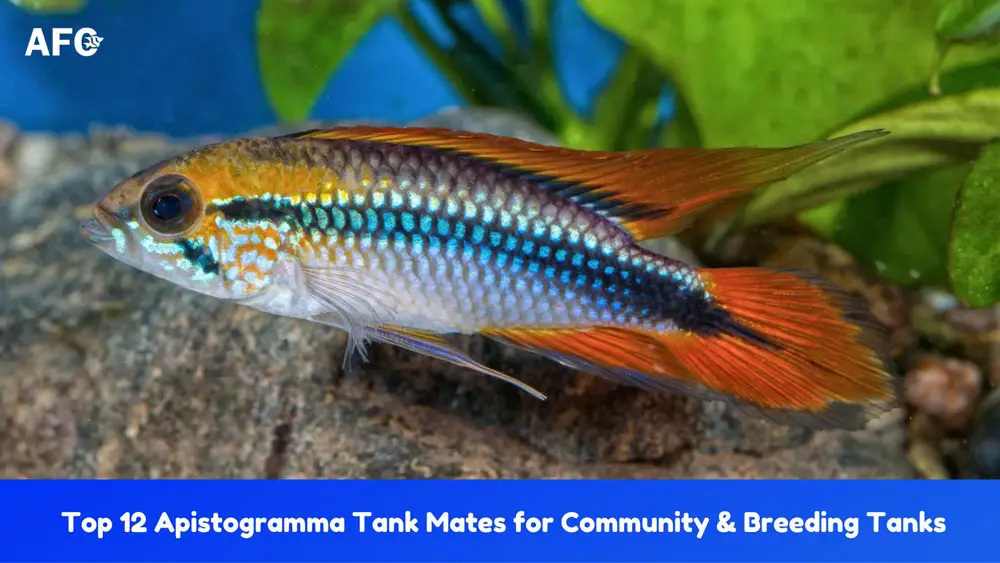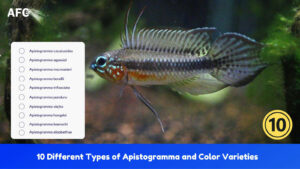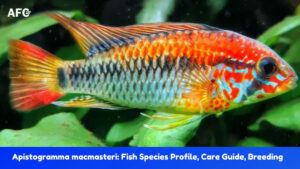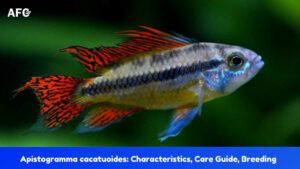Apistogramma cichlids are one of the best-known freshwater community fish because of their small size, various colors and patterns, semi-aggressive temperament, and preferred swimming level in aquariums.
In community tanks larger than 40 gallons (150 liters), non-aggressive cichlids that prefer the middle and top of the tank and thrive in similar water conditions will happily coexist with Apistogramma. Some suitable tank mates include freshwater angelfish, geophagus cichlids, keyhole cichlids, and checkerboard cichlids.
For small community tanks, similarly sized community fish, such as corydoras, otos, neon tetras, cardinal tetras, and rasbora, are good choices as companions.
In specialized breeding tanks with timid or territorial spawning Apistogramma pairs, the presence of a large group of dither fish is beneficial. Hatchetfish and pencilfish, in particular, make perfect companions as they generally do not prey on fish fry.
The following is a list of the top 12 best tank mates for Apistogramma fish.
- Freshwater Angelfish
- Geophagus cichlid
- Keyhole cichlid
- Checkerboard cichlid
- Pygmy cory
- Otocinclus catfish
- Neon tetras
- Cardinal tetras
- Marbled hatchetfish
- Harlequin rasbora
- Brown pencilfish
- Dwarf pencilfish
Freshwater Angelfish
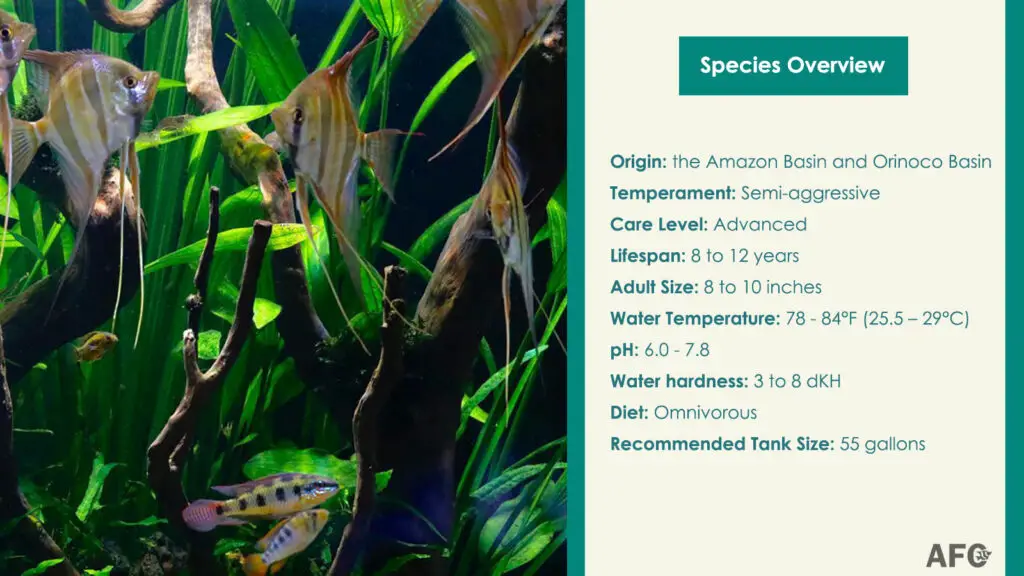
Freshwater Angelfish (Pterophyllum spp.) are relatively peaceful mid-dwelling fish, known for their graceful swimming behavior and flowing fins. They make great companions for Apistogramma fish in large community aquariums.
Angelfish originate from the tropical regions of South America in quiet, where they are found in slow-moving rivers beneath dense, overhanging vegetation that allows in minimal light.
Captive-bred angelfish can adapt to a wide range of water chemistry parameters. Since they grow to be tall, reaching 8 to 10 inches (20 cm to 25 cm) in height, they require 55 gallons or larger aquariums rather than shorter ones.
Inquisitive Apistogramma may nip the fins of long-finned angelfish varieties, and Angelfish sometimes forage for food close to the substrate. To reduce aggression risks, consider selecting short-finned varieties and spicing up the tank with live aquatic plants and hiding spots.
Geophagus Cichlids
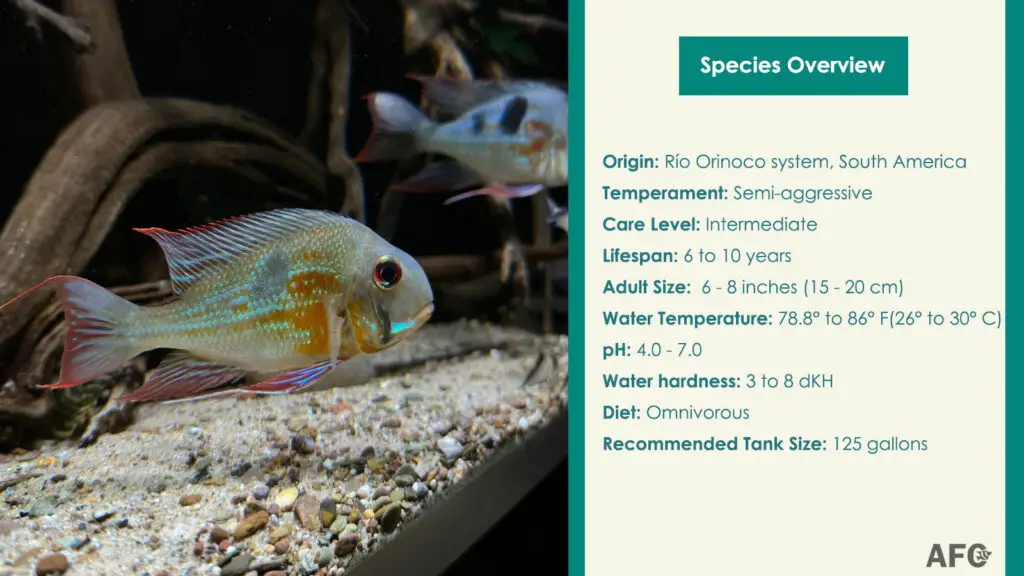
Geophagus and Apistogramma are closely related cichlid genera that belong to the Geophagini tribe. These sand-sifting cichlids share similar physical and behavioral traits, including vibrant coloration, varying sizes, and intriguing social behavior. As a result, they tend to get along in a spacious community tank of at least 125 gallons (473 L) in size.
The biggest concern when keeping Geophagus and Apistogramma together is their territorial nature as bottom-dwelling cichlid fish. They establish and defend their own areas in the tank, so they must be kept in large tanks with plenty of shelters.
Remember that Apistogramma and Geophagus are large families of diverse species that differ in temperament, size, and breeding strategies. To ensure compatibility with Apistogramma, choose the smaller Geophagus species, such as G. brasiliensis, G. altifrons, or G. proximus.
Keyhole Cichlids
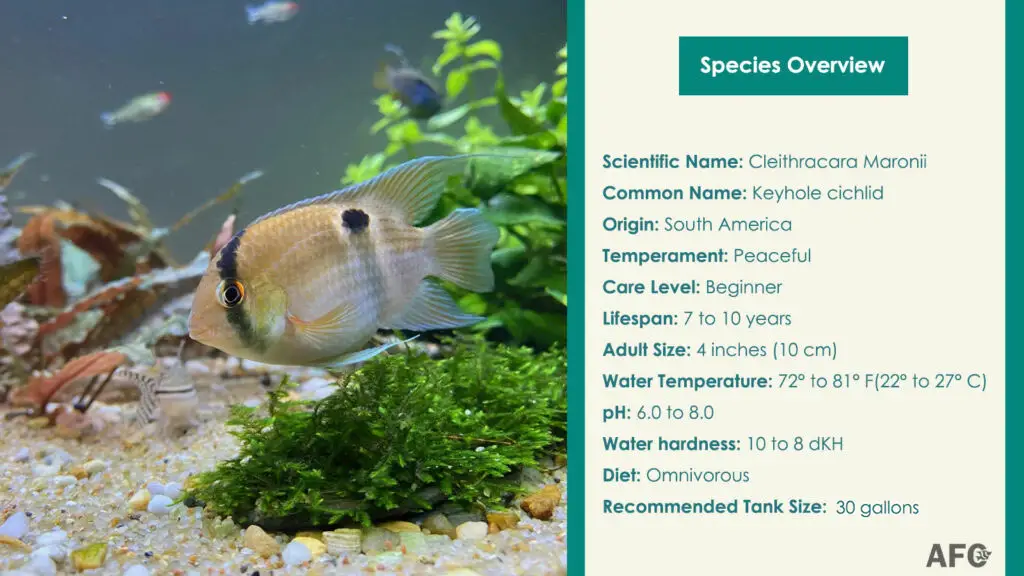
The small and timid keyhole cichlid (Cleithracara maronii) can serve as good tank mates for Apistogramma fish in medium-sized community tanks that are 30 gallons or larger in size.
While keyhole cichlids tend to stay near the floor of the aquarium and may compete for space with Apistogramma, they particularly enjoy a planted tank with tall plants in the middle area where they can hang out.
Admired for their peaceful nature, these friendly creatures typically reach a length of 4 inches (10 cm) and can adapt to a wide variety of water conditions.
Well-caught specimens thrive in an environment similar to that of Apistogramma, characterized by very soft and acidic water resulting from fallen leaves, decaying wood, and other organic matter.
Checkerboard Cichlids
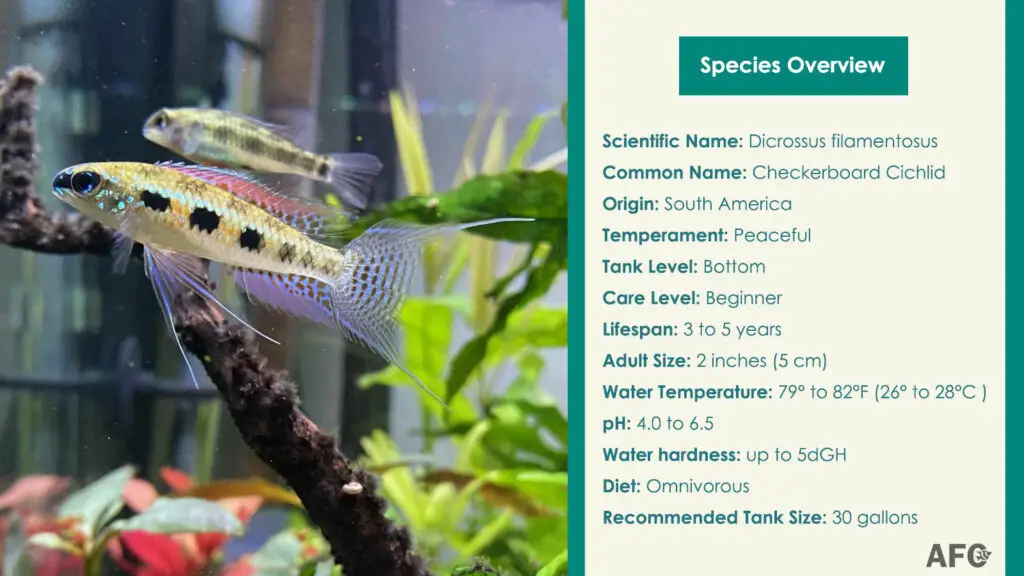
Although the Checkerboard Cichlid (Dicrossus maculatus) may not be as widely recognized as Apistogramma fish, it is another peaceful dwarf cichlid native to South America. Due to their similar natural habitat preferences, they make suitable companions for relatively peaceful Apistos in large community aquariums.
Checkerboard cichlids are distinguished by their striking pattern of two rows of square black spots along their flanks, creating a remarkable checkerboard-like appearance.
These diminutive cichlids reach an average size of 2.4 inches (6.0 cm) and thrive best when kept in schooling groups of at least five specimens. They are often observed swimming in sizable shoals near the substrate.
As crevice spawners, checkerboard cichlids do not compete with Apistogramma for spawning sites. However, make sure to get at least one tall plant with broad leaves where they can deposit their eggs.
Pygmy Corydoras
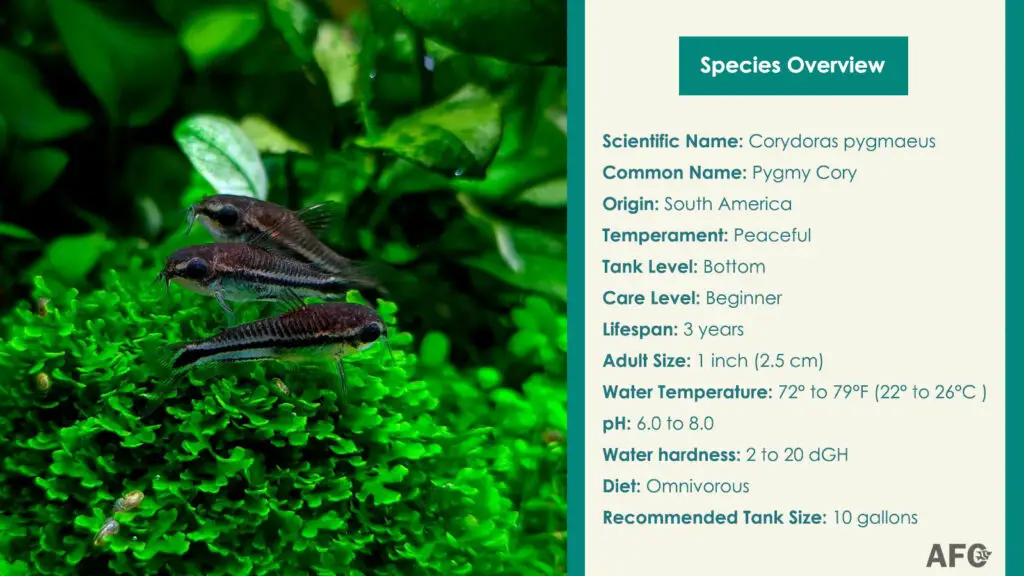
The Pygmy Cory Catfish (Corydoras pygmaeus) is beloved by Apistogramma enthusiasts for its tiny size, adorable appearance, ease of care, and peaceful and social disposition. This 1-inch South American shoaling fish makes a lively addition to any community setup.
Like most corys, pygmy corys like to shoal together in the bottom to middle levels of the tank and would do best in a group of six or more of their own species.
These playful catfish can be helpful as a clean-up crew in large breeding tanks. However, as mentioned, they have a tendency to be egg/fry predators, so they should be removed during the breeding season to increase the survival rate and growth of the Apistogramma offspring.
Otocinclus Catfish
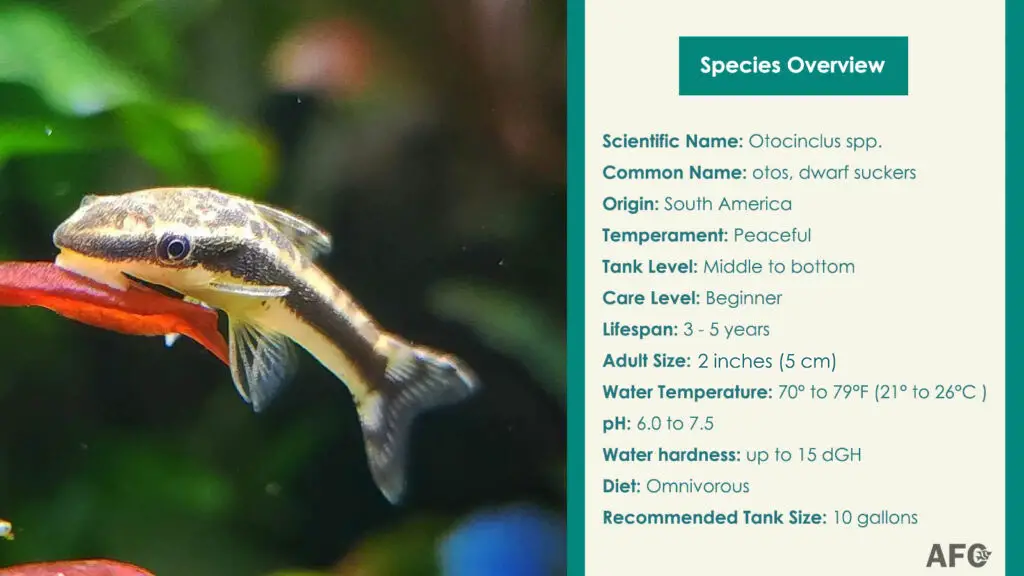
The Otocinclus catfish, also known as “dwarf suckers” or “otos,” are excellent algae eaters for Apistogramma tanks. They remain small, typically under 2 inches (5 cm) in length, and their slender bodies enable them to access hard-to-reach algae spots.
These petite fish swim between the middle and bottom of the tank and often be found hanging out live plants or other decorations using their suckermouths. By doing so, they can clean the decaying debris and algae off of the live plants.
Also, they’ll happily eat Apistogramma eggs and fry, so it is necessary to separate them when Apistos are breeding.
Oto cats live in schools, requiring at least three to six individuals to feel comfortable and safe in the aquarium. These fish are easy to care for and hardy because their modified digestive tracts can allow them to breathe air in water.
Neon Tetras
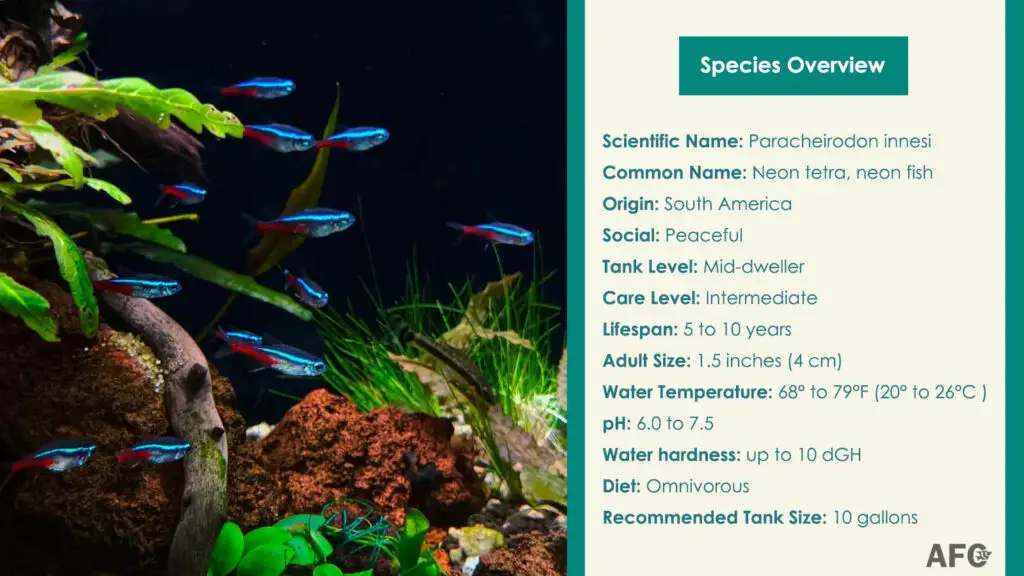
Naturally found throughout the Orinoco and Amazon river basins, the Neon Tetra (Paracheirodon innesi) is one of the most popular small tetras that can live in perfect harmony with the Apistogramma species.
Neon tetras are docile and peaceful schooling fish that prefer the middle and upper areas of the tank. Always get at least a school of half a dozen or more of them, so they can feel safe and show their interesting social behaviors.
While breeding Neon Tetras in captivity can be challenging due to their specific water requirements, they are fairly easy to care for and readily available in pet stores.
Cardinal Tetras
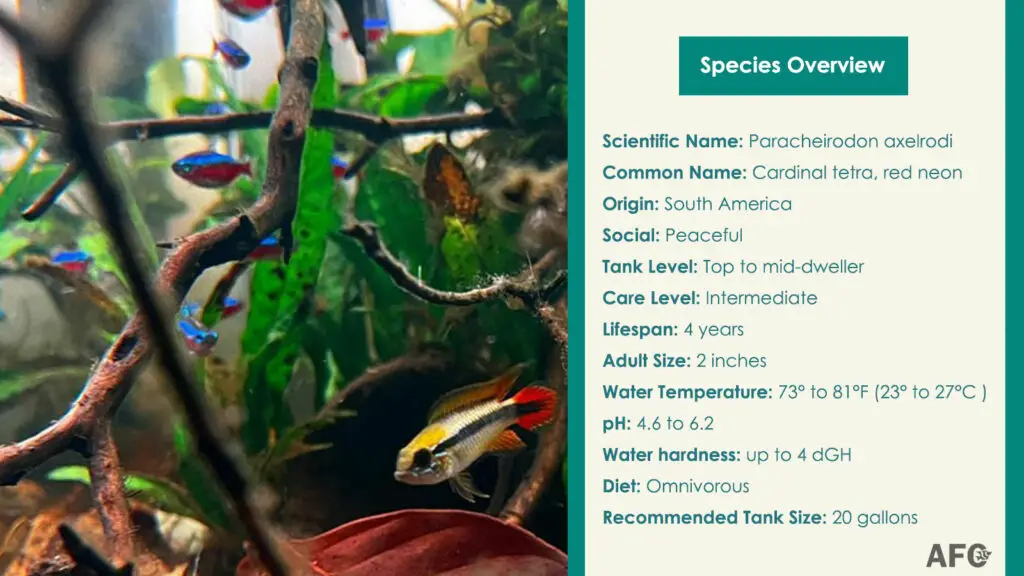
The Cardinal Tetra (Paracheirodon axelrodi) is a similar-looking relative of the Neon tetra and can also be easily introduced to Apistogramma tanks. However, most tetras, including Cardinals, have a reputation for preying on fish fry at the first opportunity.
Cardinal Tetras are peaceful schooling fish that prefer the middle levels of the tank and should be kept in groups of at least six individuals. Breeding this species can be challenging, and the majority of specimens available in pet stores are caught from the wild.
In their natural habitat, Cardinal Tetras inhabit extremely soft and acidic water with a pH ranging from 4.6 to 6.2 and very low conductivity. Therefore, these tetras can be more demanding in water quality compared to Neon Tetras in home aquariums.
Marbled Hatchetfish
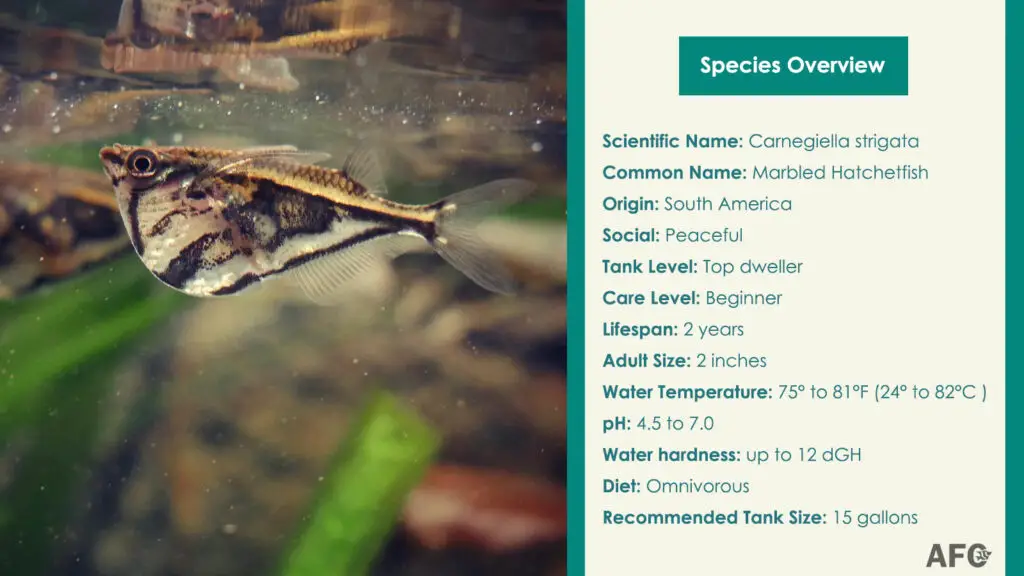
The 2 inches (5 cm) marbled hatchetfish (Carnegiella strigata) is a good dither fish to create optimal tank environments for Apistogramma in tanks larger than 20 gallons. Swimming around the top of a tank, these fish can help Apistos feel more comfortable.
This South American tropical fish has a very unique hatchet-shaped body with wing-like pectoral fins. Its pectoral muscles are so powerful, allowing it to leap out of the water to escape predators.
Marbled hatchetfish need to be in groups of at least 6–12 fish for socializing and schooling. In order to make them feel secure, provide ample hiding spots like wood and floating vegetation in the upper levels of the tank. Additionally, a tight-fitting lid is a must to prevent escapes.
Harlequin Rasbora
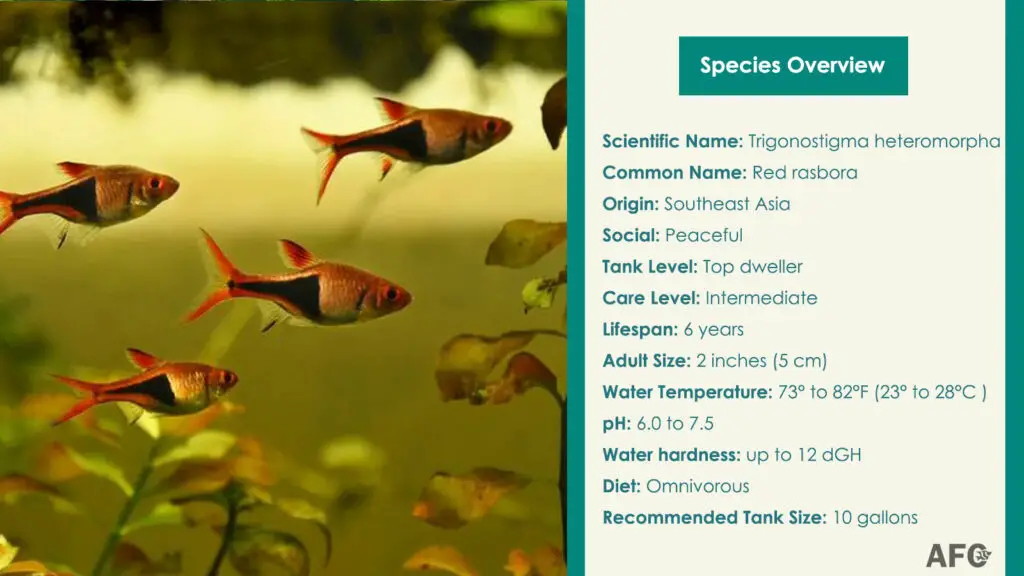
Despite being native to the Asian continent, the Red Rasbora (Harlequin Rasbora) proves to be a good neighbor for Apistogramma in smaller-sized tanks due to their shared environmental condition requirements.
These peaceful schooling fish mostly swim in the middle to top levels of the tank. Given their compact size, they do best when kept in larger groups of 10 or more individuals of the same species.
With an average length of 2 inches (5 cm), they boast a reddish body adorned with a distinct wedge-shaped patch that starts at the dorsal fin. This striking feature beautifully contrasts against the backdrop of lush greenery.
Dwarf Pencilfish
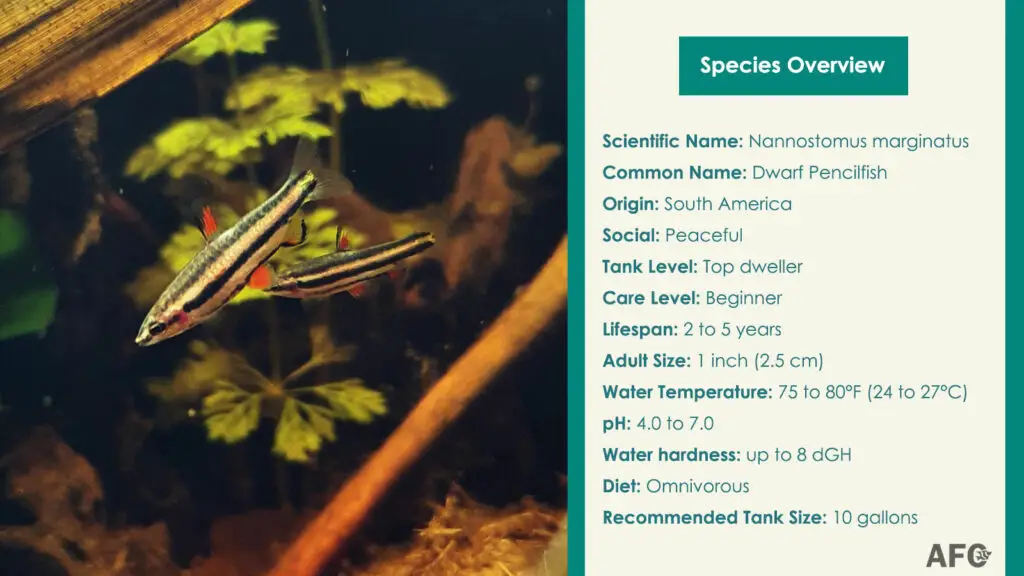
The Dwarf Pencilfish (Nannostomus marginatus) serves as the best dither fish for breeding pairs of Apistogramma since their mouths are too small to prey on the fry, making them a safe choice.
Being the smallest pencilfish species, they grow to around 1 inch (2.5 cm) in length. Unlike other dither fish, they do not strictly school together, so having 1-2 dwarf pencilfish is very suitable for 10-gallon Apistogramma breeding tanks.
As with most pencilfish, they greatly appreciate the roots and upturned leaves of floating plants near the surface, where they mostly hang out and congregate on the underside for both shelter and feeding.
Brown Pencilfish
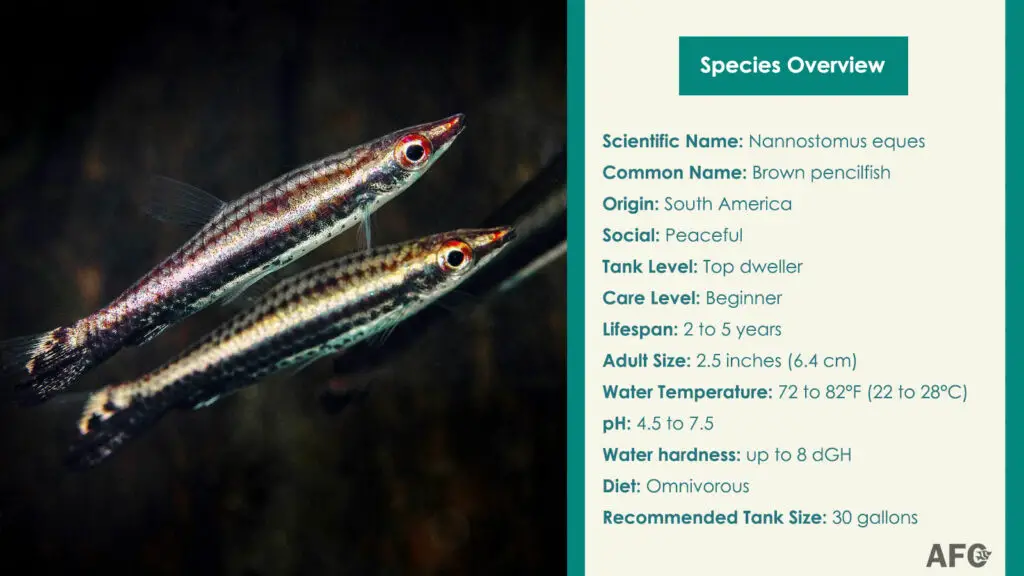
The Brown Pencilfish (Nannostomus eques) is an excellent alternative to the Dwarf Pencilfish since it is more readily available in the aquarium trade. As a larger pencilfish that grows up to 2.5 inches (6.4 cm) long, it is more suitable for medium to large Apistogramma aquariums.
These fascinating top-dwelling fish can bring out their best behavior when kept in groups of 10 or more individuals. They often remain a distinctive ‘head up’ posture with their mouths facing the water’s surface.
Like the other fish species mentioned, Brown pencilfish prefer warm, soft, and acidic water conditions to thrive and encourage spawning. However, they are quite adaptable and can tolerate a range of water conditions.
What Other Fish Can Live with Apistogramma?
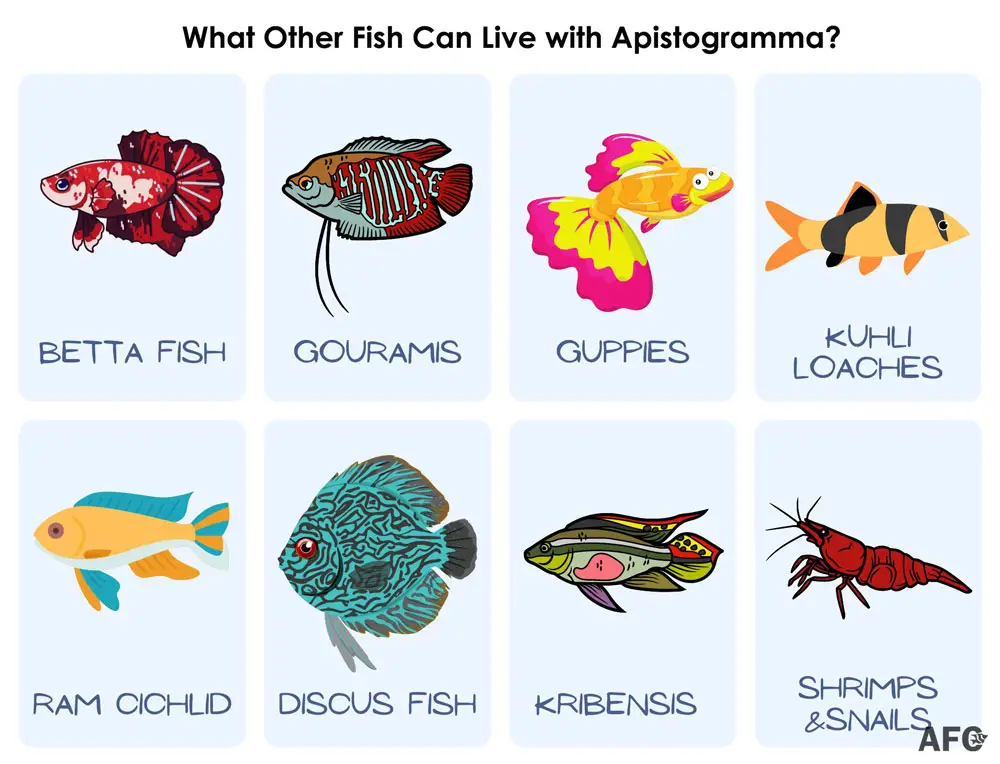
While some aquarists have reported successful experiences pairing Apistogramma with other fish species and aquatic invertebrates, the compatibility of these creatures remains a topic of ongoing debate within the aquarium community.
The following are some of the commonly discussed fish and invertebrates that could be considered as potential tankmates for Apistogramma cichlids in community tanks.
- Betta Fish
- Gouramis
- Guppies
- Kuhli Loaches
- Ram Cichlid
- Discus fish
- Kribensis
- Shrimps
- Snails
Can You Keep Apistogramma and Betta Together?
Yes, you can keep Apistogramma and Betta together in a community tank setup.
Betta fish are surface dwellers and mostly swim in the upper third of the aquarium. Additionally, both species thrive in a well-planted tank, particularly with floating plants, and prefer soft, acidic water conditions.
Can Apistogramma Live With Gouramis?
Yes, captive-bred Apistogramma and gouramis can coexist in community tanks, but not all gourami species are compatible.
The Pearl Gourami is considered the hardiest and most adaptable species, making it a potential tankmate for Apistogramma.
Be cautious with the smallest Sparkling Gourami and the most recognized Dwarf Gourami. The former is typically a wild-caught species, while the latter is known to be susceptible to the deadly Dwarf Gourami Iridovirus (DGIV).
Can Apistogramma Live With Guppies?
Yes, Apistogramma and guppies can live together in the same tank on a short-term basis if you want both fish to thrive.
Guppies are often found in hard, more alkaline water, some even from brackish to full marine environments near the coastline. Apistos, on the opposite side, originate from soft, acidic water in rainforest streams.
Besides the different water quality requirements, guppies are not faster swimmers, and Apistos will not hesitate to rip off a guppy’s tail if given a chance, even though they are not known as fin nippers. This poses a severe risk of injury or death for your fish, which should be avoided at all costs.
Do Apistogramma Get Along with Kuhli Loaches?
Apistogramma often do not get along with Kuhli loaches.
Kuhli loaches are large bottom dwellers that compete with Apistogramma for territory and food. Being nocturnal fish, Kuhli loaches may enter Apistogramma’s caves and prey on their eggs or fry during the night. Additionally, black Kuhli loaches have a notorious reputation for nipping the fins of their tank mates.
Can Apistogramma and Ram Cichlids Live Together?
Yes, Apistogrammas and Rams can live together harmoniously in most instances, but Ram cichlids are not the ideal tank mates for Apistogrammas.
The primary reason is that Rams require higher temperatures, ideally between 84-86°F (29-30°C), to thrive compared to Apistogramma. The elevated temperatures that benefit Rams accelerate the metabolism of Apistogramma, which can potentially shorten their lifespan.
Can You Keep Apistogramma and Discus Fish Together?
Yes, you can keep Apistogramma and Discus Fish together, but this combination should only be attempted in larger, well-structured aquariums that provide ample hiding spots.
Discus are middle-dwelling fish, and these schooling fish do best when kept in groups of at least six individuals of their own kind.
Similarly, the most critical water parameter of Discus fish husbandry is the temperature, which should be maintained between 82° to 86°F (28° to 30°C). Most Apistogramma species can tolerate the same high temperatures but flourish in cooler water below 79°F (26°C).
Can Apistogramma Live With Kribensis?
No, Apistogramma cannot live with Kribensis even though they enjoy the same water parameters.
Both Apistogramma and Kribensis are bottom dwellers and secretive cave spawners, leading to direct competition for food, territories, and spawning caves. Kribensis are larger in size and more aggressive than Apistogramma, which further intensifies the incompatibility between the two species.
Can Shrimp Live with Apistogramma?
No, shrimp cannot live with Apistogramma, as they are prone to being eaten by Apistogramma, especially the small and brightly colored cherry shrimp.
However, some hobbyists have reported success in keeping Amano shrimp with Apistogramma borellii. This is possible due to the Amano shrimp’s larger size and the generally peaceful nature of A. borellii.
Do Apistogramma Eat Snails?
Apistogramma eats snails, as these are part of their diet in the wild.
Several species of Apistogramma, including A. ortegai, A. eunotus, A. hongsloi, and A. macmasteri, particularly the last two species from the macmasteri Group, have been observed crushing snail shells against the aquarium decor or glass walls and consuming the meat.
Can Apistogramma Dwarf Cichlid Live Alone?
Yes, Apistogramma dwarf cichlids can live alone, and a single male can be placed in a small, densely planted tank as the centerpiece fish.
While Apistogramma cichlids are not schooling fish, they are commonly kept in pairs or small groups of one male and multiple females.
Can You Keep Different Species of Apistogramma Together?
Yes, you can keep different Apistogramma species in the same tank, but most experts and enthusiasts advise against it due to potential reproductive issues and crossbreeding concerns.
